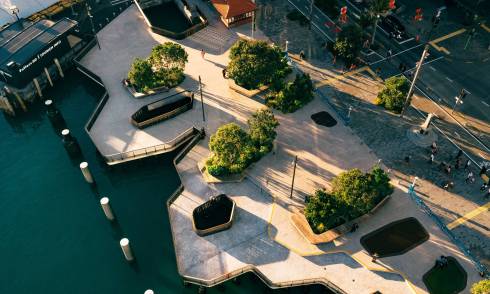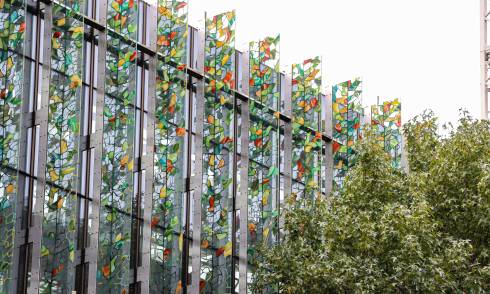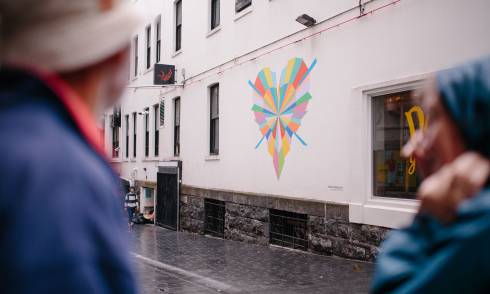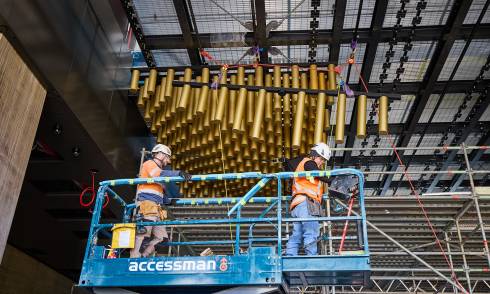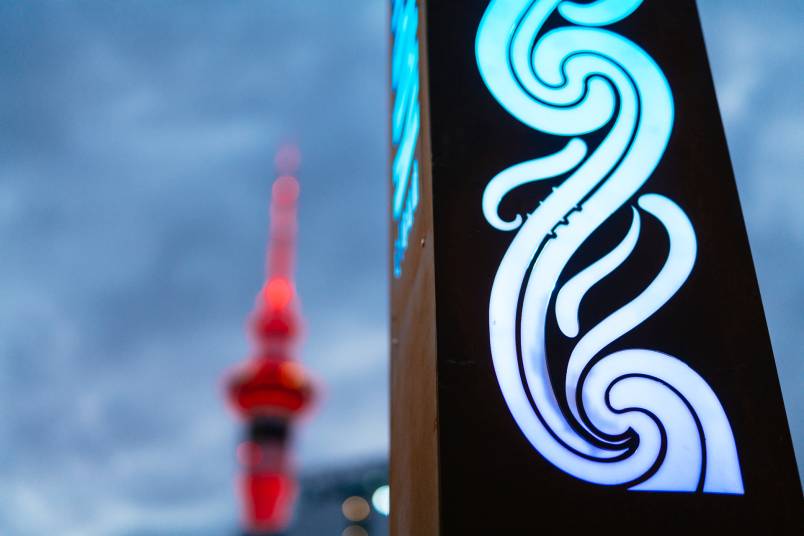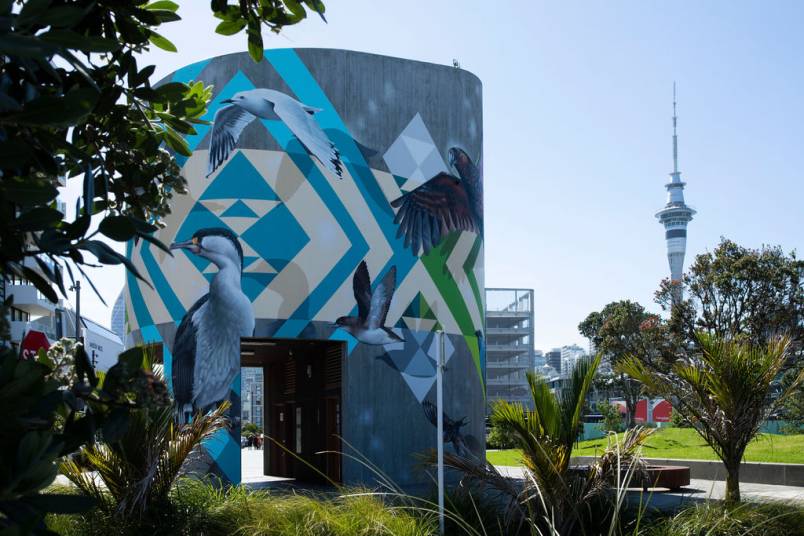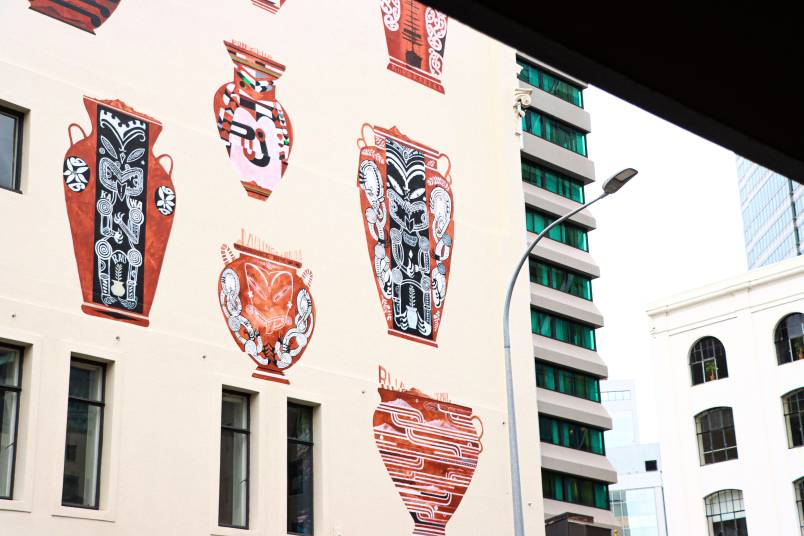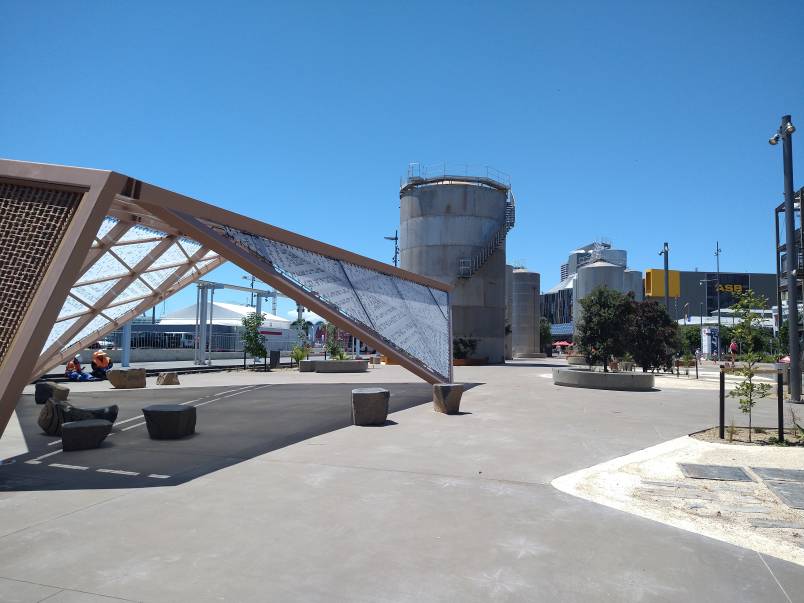If you're in the city centre this week, why not take a moment to enjoy the array of art on display in public spaces, both new and old. From Silo Park to Britomart, Aotea Arts Quarter and more, check out our top picks below to get started.
New city centre murals
Oscar Low | Corner of Fort Street and Fort Lane
Witness the transformation of downtown Tāmaki Makaurau through Ross Liew's latest artwork—a captivating roller door piece that reflects over 15 years of artistic mastery. Situated in the heart of Te Waihorotiu, this mural draws inspiration from the surrounding environment, incorporating unique letterforms that resonate with the city's energy.
Margarita Vonva | 25 Victoria Street West
Keep an eye out for this stunning Japanese-inspired masterpiece by Margarita Vonva on Victoria Street West. This captivating artwork, abundant in intricate details and vibrant colours, pays homage to Japan's cultural richness. Whether enjoying a meal at Daikoku or simply strolling through Victoria Street, take a moment to admire this remarkable Japanese-inspired masterpiece.
Owen Dippie | 156 Victoria Street
Owen Dippie is a New Zealand street artist internationally recognised for his incredible large-scale murals. His latest masterpiece of UFC Middleweight Champion, Israel Adesanya can be found on Victoria Street and is well worth checking out!
(Top left: mural by Owen Dippie, top right: mural by Ross Liew, bottom: mural by Margarita Vonva)



On the water's edge
Te Wānanga
Te Wānanga is where the city meets the sea, it brings to life the breath of Tangaroa, the natural rhythm between high and low tides. Beautiful pōhutukawa trees recall the coastal forest that once was, while mussel beds and kelp forests below provide a restored habitat for native species beneath the waterline!
Te Ngau o Horotiu
Te Ngau o Horotiu (the bite of Horotiu) is named after the taniwha of Te Wai o Horotiu, the river that once flowed through this landscape from the top of Myers Park to the bottom of the Queen Street Valley. Te Wai o Horotiu is now hidden beneath Queen Street, but its significance and history are reflected in the local topography and city infrastructure.
Te Wairere
Te Wairere design appears throughout the waterfront space as a contemporary visualisation of manaia – a stylised figure often used in traditional Māori wood, stone and bone carving.
These city centre artworks are proudly commissioned by Auckland Transport.
(Top left and right: Te Wānanga, bottom: Te Wairere)



Te Hoahoa o ngā Maru – Canopy design
The sail-like canopy at Te Ngau o Horotiu references the sails of waka hourua on which our ancestors travelled to Aotearoa from their ancestral home – Hawaiki.
Ngā Paiherenga Rōau me ngā Haumi – Handrail Binding and Haumi Joints
Natural fibre is woven into these handrails in a binding design reminiscent of the toki used in the traditional crafting of waka. Haumi is a traditional fixing technique typically used to join together the length of a waka. This tradition has been used in the nōhanga of Te Wānanga as a further reflection of Te Wānanga as an “in-between” space that symbolises the binding together of tāngata, whenua, and moana.
The Lightship | Quay St Wharf
Crafted from nearly 8500 LED lights, this large-scale contemporary art installation stands at 13 metres high and stretches 110 metres long. The Lightship is an initiative by Ports of Auckland paying tribute to the city’s artists. In a world filled with upheaval and turmoil, The Lightship is employed to connect people through light on the Auckland waterfront. The art on display changes frequently. Read more about it here.
These city centre artworks are proudly commissioned by Auckland Transport.
(Top left: Ngā Paiherenga Rōau me ngā Haumi, top right: Te Hoahoa o ngā Maru, bottom: The Lightship)



More around the city centre
Te Maharatanga o Ngā Wai, Remembering our waters | Sale Street
While many of the natural waterways that once flowed through Auckland’s city centre have been lost from sight – channelled, piped, and progressively covered over – a new Māori design kaupapa will see those urban waters remembered. Two laser-cut corten steel pourama (light columns) spill light through the lettering, casting kupu reo (words) onto the pavements with themes of kapua (cloud), ua (rain), awa (river), moana (sea) that describe the natural water cycle, and an overarching message: oranga wai, oranga tāngata (healthy waters, healthy people).
Scan a QR code on the side of the two steel pourama and hear a poem by celebrated New Zealand manu kōrero/poet Hone Tuwhare recited in both te reo Māori and English by the children of the young men who have led this project. Hone Tuwhare remains a national treasure and stands as one of the most important Māori literary voices of the twentieth century. Read more, here.
CRL Te Waihorotiu Station | City Rail Link
Ceiling rods have been added to the front foyer of the new CRL Te Waihorotiu Station. These rods mimic the stems of harakeke and the movement of the Waihorotiu stream. This new 15m-deep 300m long underground station is expected to be the country’s busiest train station.
Mai i ngā maunga ki te moana, Janine and Charles Williams | Amey Daldy Park | Wynyard Quarter
Wynyard Quarter’s pump station in Amey Daldy Park has an exciting new look inspired by Aotearoa’s manu māori, our native birds.
The new mural, created by mana whenua artists Janine and Charles Williams, is named ‘Mai i ngā maunga ki te moana’ (from the mountains to the sea). At 12 metres high and spanning 16 metres wide around the pump station structure, the mural features 12 native birds to remind us of our roles as kaitiaki (guardians) of our natural environment. Each manu (bird) faces their respective habitats, be it moana (ocean), takutai (beach/shore) or pararau/repo/maunga (forest/swamp/mountains). Read more about the work, here.
Maunga | Shane Cotton mural | Britomart
Located at the corner of Commerce and Customs Street, this permanent art piece covers the western wall of Excelsior House. Created by Shane Cotton in collaboration with artist Ross Liew, Maunga consists of 25 works painted onto the five-storey high building. The pot motif, inspired by Cotton, symbolises how people bring their own landscapes and scenery into Auckland. Originally a European concept for storing belongings, the motif has been visually adapted into Māori art. Visit to discover the artwork's meaning for yourself.
Installations at Silo Park
Visit the newly extended Silo Park and discover the new installations by Tessa Harris and Reuben Kirkwood, artists from Ngai Tai Ki Tamaki. Harris' pavilion, named Te Nukuao and inspired by waka, reflects the identity of mana whenua while also offering practical shelter from the elements. Kirkwood has designed concrete etchings on the park's surface, drawing inspiration from the stars that guided waka hourua at sea.
Sun burst by Sara Hughes
Diverse and colourful artworks in the shape of a heart were created on various walls in the city centre back in 2016 as part of a series of Hearts of the City artworks, and are still going strong today! Check out Sarah Hughes colourful artwork on Fort Lane which references the architectural details of Auckland's art deco and heritage sites. Like a sun burst this heart is exploding with everything life has to offer - Sara hopes that its rays will be positive and life affirming to passersby.
Sara Hughes artwork | New Zealand International Convention Centre (NZICC)
When open, the New Zealand International Convention Centre (NZICC) will host over 3000 conference delegates and provide a public laneway with exciting new hospitality offerings. Its façade is already adorned with the country's biggest ever public artwork - enormous glass panels (550 in total) by artist Sara Hughes. Hughes was brought up in rural Northland near the Waipoua kauri forest, with this being the inspiration for the detail on the glass. 60 different colour tones are used to create a breathtaking result, which aims to invoke the feeling of walking through native bush in Aotearoa, a welcome juxtaposition in a busy and metropolitan city space. The panels will sit alongside an equally huge terracotta tile work being created separately by artist Peata Larkin - together eventually spanning a grand total of 5,760sqm once fully
installed.
